It is good to have boardgame friends all around the world. Writing a blog inevitably means that you meet many fellow hobbyists, designers, content creators, etc. Dave – also knowas whovian223 – who owns and runs Dude! Take Your Turn! blog, is probably one of my closest “internet friends” I met during the past years. So when your friend is in need what do you do? You help!
Pandemic had a widespread impact on all of us. Also on our hobby – when recently GMT charged and shipped Caesar: Rome vs. Gaul, it occurred that due to the closure of the US-Canada border, Dave will not be able to get his copy of the game until late into 2021. So the only way to play that title was via Internet.
I immediately agreed to help Dave and take part in the Play-by-Email (PBEM) game. As for the Imperial Struggle Tournament, I suggested using the Discord. This is really great tool for you to keep all the logs, and using the Discord DiceParser you can execute objectively all the important rolls. Not to mention almost instantaneous communication with opponent when question of Avoid Battle / Intercept / Surprise Event is concerned.
But before describing our session, couple of word about the game itself.
About the game
(as per GMT site) Caesar: Rome vs. Gaul is a fast-playing, easy-to-learn, two-player card-driven game on Caesar’s conquest of Gaul. One player plays Caesar as he attempts to gain wealth and fame in Gallia at the expense of the Gauls. The other player controls all the independent tribes of Gaul as they slowly awake to the peril of Roman conquest.
Caesar: Rome vs. Gaul uses many of the core rules and systems used in Hannibal: Rome vs. Carthage. Players are dealt 8 cards at the start of each turn and use their cards to move their armies and place control markers.
The game covers the height of the Gallic Wars, the period between 57 BC and 52 BC when Caesar campaigned back and forth across Gaul putting down one rebellion after another and invading Germania and Britannia. Units are individual Roman Legions or Gallic Tribes. Each turn represents one year.
First session
In our first game we decided I will take Romans while Dave will be playing Gauls. It was first real wargame for him after many years so we thought it prudent for me to take on more complex and active faction. Let me present briefly what happened and how it went!
A short legend to below report:
- in red I marked Roman developments, axis of attack, killed tribes and any other significant events
- in green you can see which tribes arrived at the beginning of the turn; also minor/major uprisings are marked like this
- in blue – mainly the spreading Gallic influence
You can also click on each image to enlarge it. Enjoy!
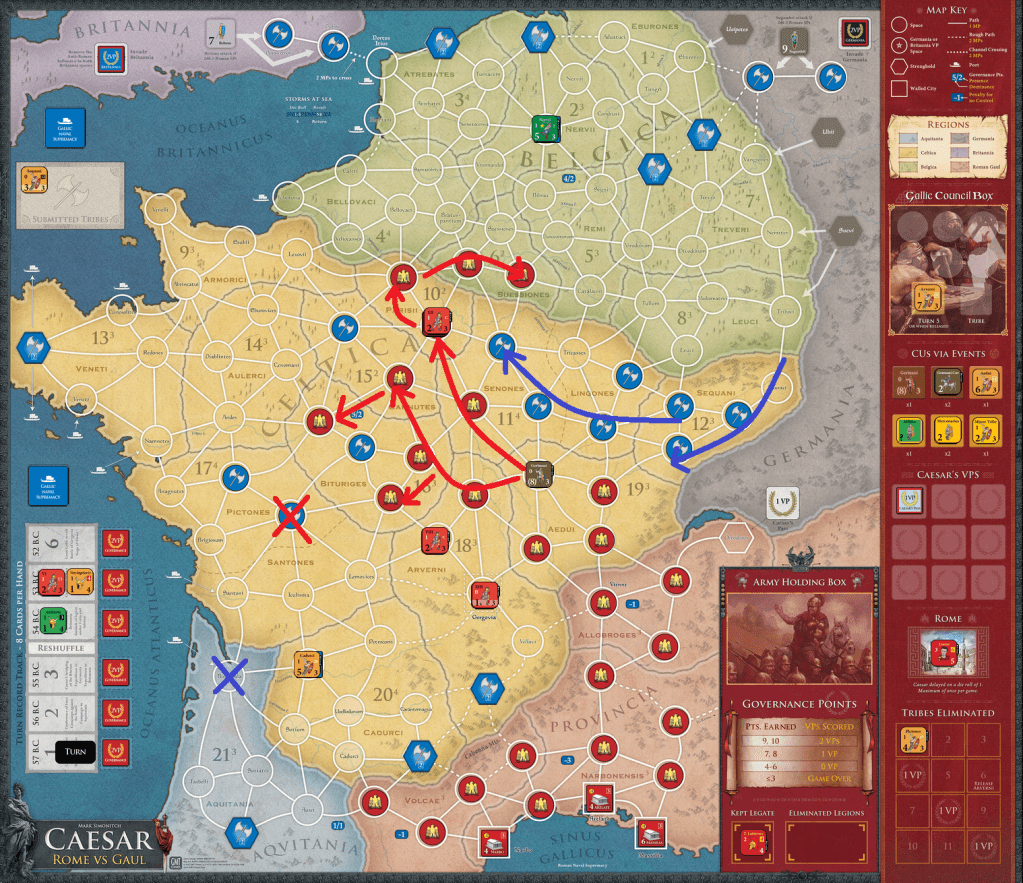
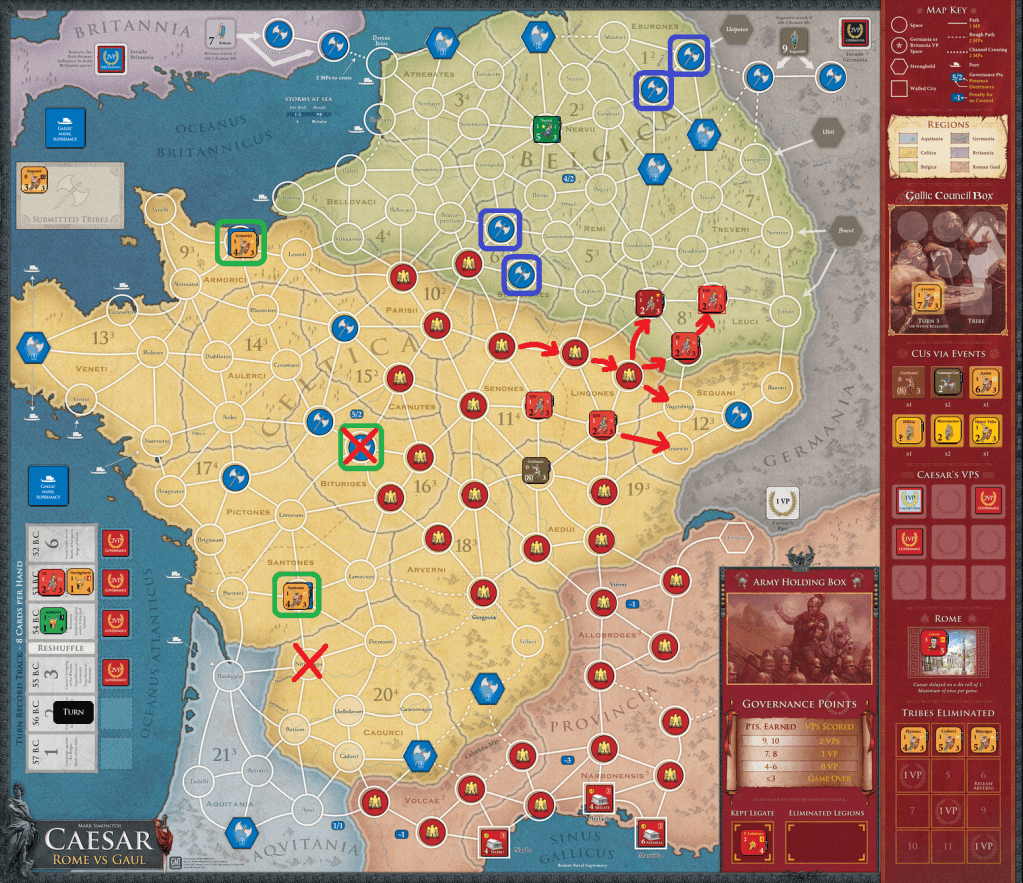
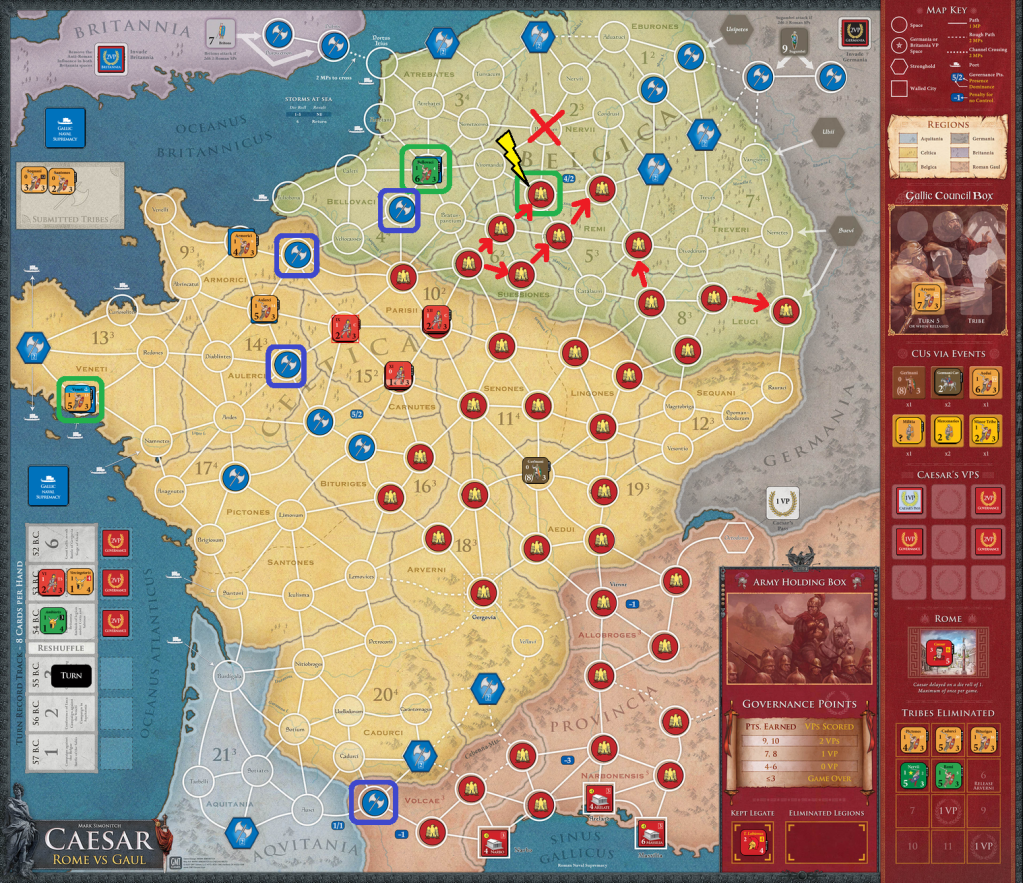
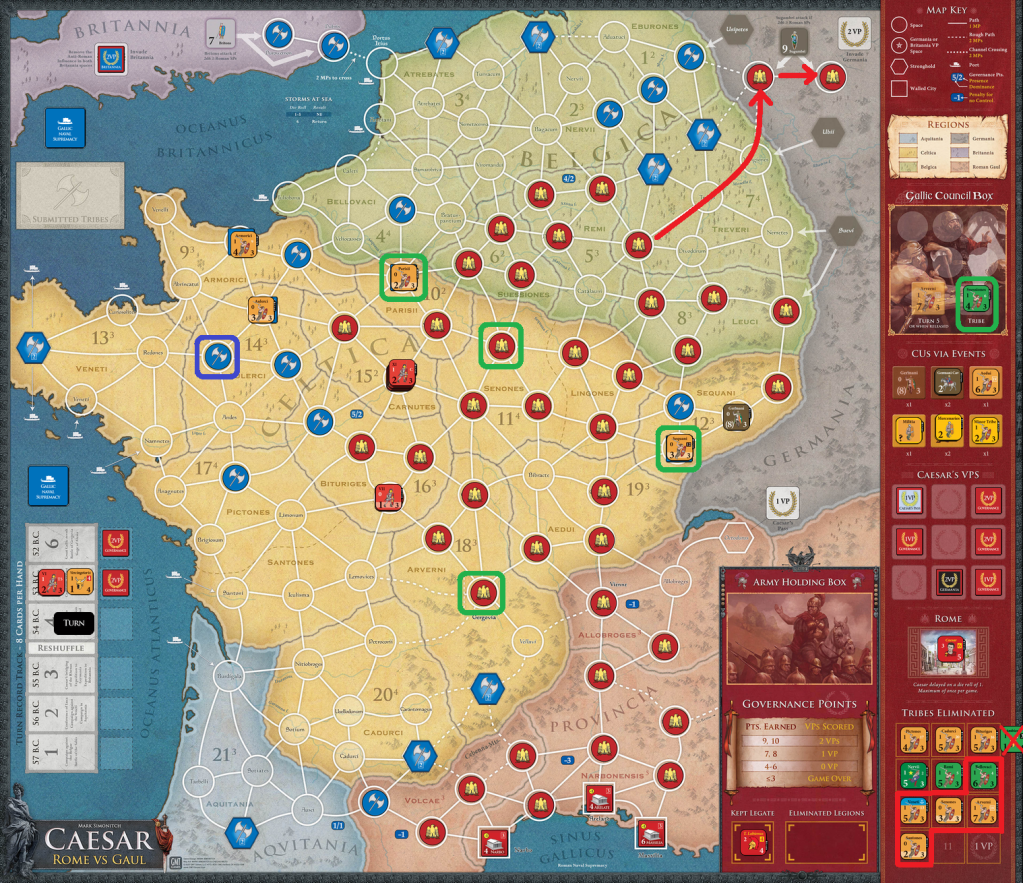
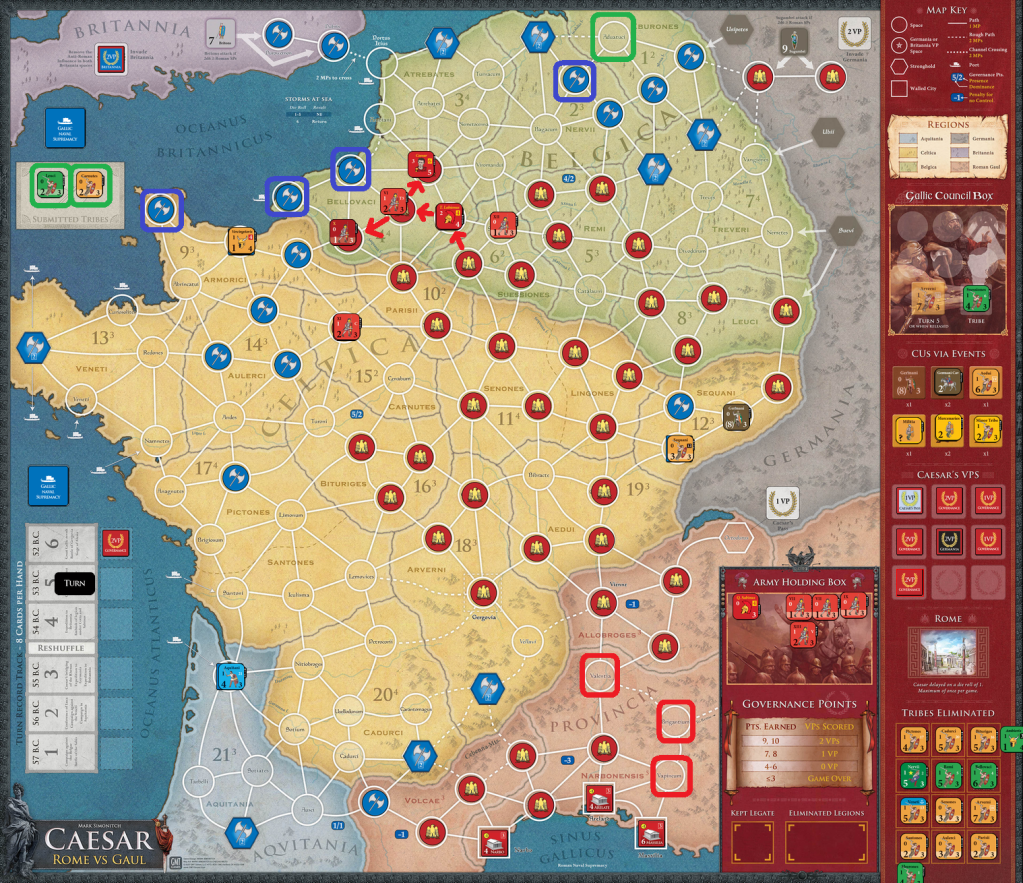
At this moment we decided to end the game. There was technically a possibility for Romans to lose (governance 3 or less) but looking at the map that was highly unrealistic.
Observations from the Roman perspective
Below couple of things I learned playing – and believe me, that game, while not overly complicated, will definitely favor players knowing the cards, mechanics and how it all works:
- Caesar pass – one of the most crucial places on the map; not only it is worth 1 VP but also a source of supply and a possible location to start insurrection actions behind enemy lines (see our second game 🙂 )
- Supply lines – I learned they are really key and was doing whatever possible to keep them secured. It is not only matter of attrition but also possibility to place Caesar and Legates.
- Caesar has a great mobility – ability to move 5 hexes with 6 legions is a great advantage – sometimes my move was creating so much dread among the Gauls, that they were afraid to leave their cities for offensive action.
- Use wisely the Legions Winter quarters – it is powerful tool but use it with caution! Make sure you have two legions in neutral space, make sure that province after winter will be allied to Romans and set your 2-legion quarters each to another so they can possibly intercept incoming enemy.
- Count your points – you have 12 to accumulate and 6 turns to do it; make sure you get 2 each turn – this or that way – not to be surprised later and trying to catch-up! Except for governance, the expedition to Germania or Britannia will help greatly, not to mention every 4 tribes eliminated.
There will be possibly much more once I play more (and I will). For now, those sometimes pretty obvious observations will make the life of any Roman commander much easier.
Summary
That was a good game. Dave already described his perspective, playing as Gaul player. I really like the asymmetry of the game – each side should use completely different approach and tactics. The game is beautiful, tense and interesting. I am seriously intrigued and already wondering what next game in series could be. Highly recommended!




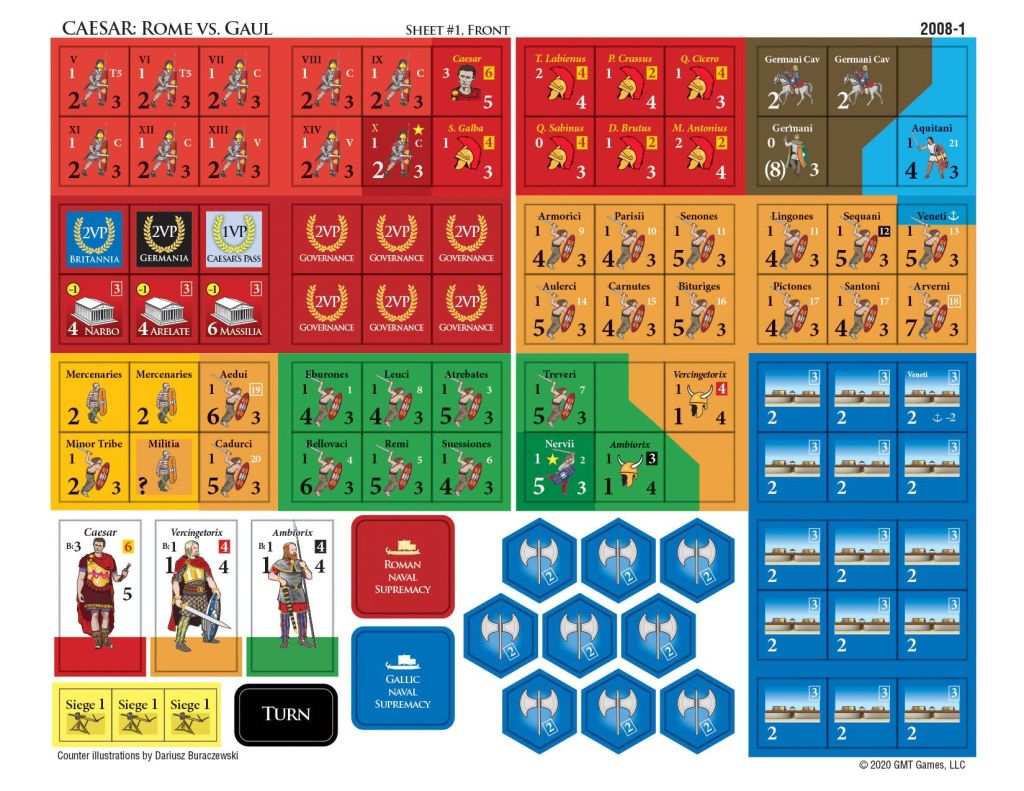
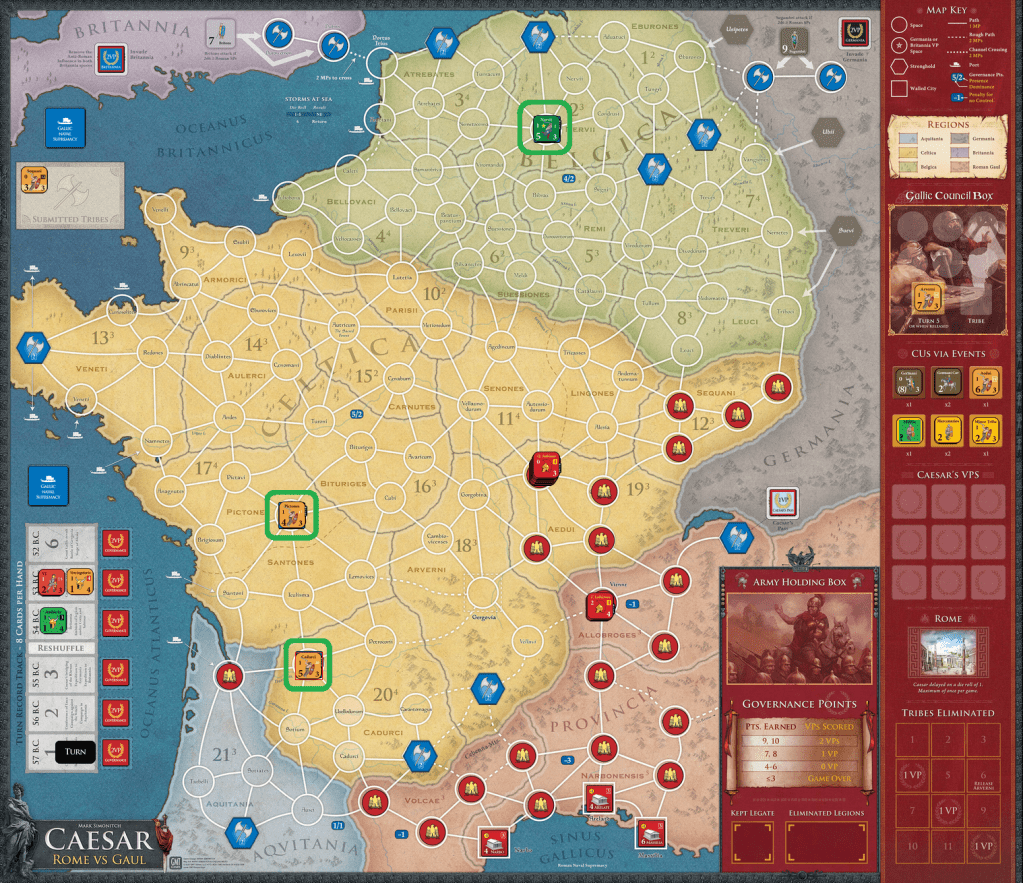
Great overview! Much more detailed than mine. 🙂
That Gallic massacre on Turn 3 when I should have at least done some damage to your legions really hurt. I think it was the turning point of the game (though you would have won still, I believe).
Still a hell of a lot of fun and who said you can’t have fun while being mauled? 🙂
LikeLiked by 2 people
That was such a refreshing experience. I played a lot of wargames, and pretty many with Rome in subject but that was something new, which made me want to discover the subtleties of that title!\
LikeLiked by 1 person
Turn 3 – Are you sure you played well?
“A large mass of enemy tribes attack legions…” You write briefly, but only one tribe can attack at a time, unless they are led by a leader.
LikeLiked by 1 person
First, two tribes can move as one stack without any movement penalties (they have a leadership rating of 1 so can bring another tribe with them).
Secondly, the Spring movement (prior to the first round), you can join them all together and then attack as one stack, no matter how many tribes you have (having more than the leadership rating just means you pay more movement points to move…stacking limits are unlimited).
Believe me, it should have worked. I may have taken some damage (and expected to) but I should have mauled those legions as well. Instead, they were relatively unscathed.
LikeLiked by 1 person
Nope. First, the tribes do not have the Command Rating that the leaders do to pick up CU.
Secondly, tribes cannot enter the a space containing Roman CU during spring muster phase and thus start battles.
LikeLiked by 1 person
Sorry, you’re wrong.
From 9.4: “Every Legion and Tribe has an intrinsic
Leader. Although not printed on the counter
an intrinsic Leader has a Command
Rating of 2—they can command their own
Legion/Tribe plus one other CU. Intrinsic Leaders have a Battle
Rating of 1 on the front and 0 on the back.”
So tribes have an Intrinsic leader with a Command Rating of 2. They can move 2 tribes with normal MP.
But again, that only means that it costs double MP to move even if you have more than 2 tribes.
Spring Muster, you move them all to the same spot, and then you attack (2 MP because of having more than 2 tribes).
LikeLiked by 1 person
Sorry, yes the intrinsic leader can command an additional tribe.
LikeLiked by 1 person
…But I think, according to 9.4 only one additional CU.
LikeLiked by 1 person
Yes, but again, extra tribes just means it takes more movement points to move them. They can all still attack. And they can all stack.
And besides, two tribes can often overwhelm two legions because the tribes are stronger individually than the legions. (which is what should have happened in our game, but my dice-rolling sucked)
If you’re lucky, you can get a 10-4 (or maybe 9-4) strength differential on the first turn with just two tribes.
LikeLiked by 1 person
Yes, I can see it now, thanks.
LikeLike
Turn 3 – Are you sure you played correctly?
“A large mass of enemy tribes attack legions…” You write briefly, but only one tribe can attack at a time, unless they are led by a leader.
LikeLiked by 1 person
Additional thing, sometimes those tribes attacked in waves, sometimes with Ambroix (4 units) – of course, in turn 4 with Ambroix. There are some clever ways to play with Gauls which Dave explored, even when they had no leader.
LikeLike
Gaul player forgot to call Abraracourcix ( Asparanoiks from comic series “Asterix le Gaul”) and his druid Panoramix – it’s surely because of their village in Armorica Michal decided to attack Belgium and Germania instead going deeper into the West 😉
LikeLiked by 1 person
Oh yes, that would be a formidable ally for Gauls!
LikeLike
Great to read the Roman perspective – your De Bello Gallico, so to speak 😀
LikeLiked by 2 people
And doesn’t he tell it much better than I do? LOL
LikeLiked by 2 people
I think the two reports complement each other! A pity we don’t have Gallic primary sources in real life.
LikeLiked by 2 people
Great game report! I’m a little confused, how did the Gauls remove so may Roman IMs on turn 1 (ie Sequani)?
LikeLiked by 1 person
There is a Gallic event allowing removal of all Roman IMs in one province without Roman CUs. Pretty painful one…
LikeLike